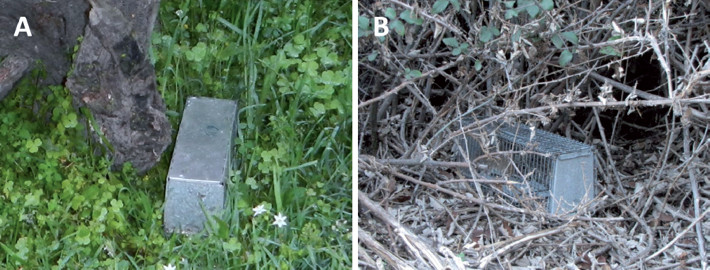Differences in the capture of small mammals between aluminum and metal mesh Sherman-like live-traps
DOI:
https://doi.org/10.31687/SaremNMS23.4.2Keywords:
central Chile, relative humidity, rodents, temperature, trapping successAbstract
We compared trapping success and selection between metal and mesh Sherman live-traps by small mammals. We measured the temperature (T) and relative humidity (RH) inside the traps in conditions of plant cover and without cover. The trapping success was significantly higher using mesh Sherman traps, but we did not detect selection for this type of trap. Without vegetation cover, the maximum interior T was higher in metal Sherman traps, and the RH was higher in mesh Sherman traps during the night. Under cover, there were no differences in maximum and minimum values between traps. We recommend the use of mesh Sherman-like livetraps to maximize captures in rapid surveys.
References
Anthony, N. M., C. A. Ribic, R. Bautz, & T. Garland Jr. 2005. Comparative effectiveness of Longworth and Sherman live traps. Wildlife Society Bulletin 33:1018–1025. https://doi.org/10.2193/0091-7648(2005)33[1018:CEOLAS]2.0.CO;2.
Burger, J. R., A. S. Chesh, R. A. Castro, L. Ortiz Tolhuysen, I. Torre, L. A. Ebensperger, & L. D. Hayes. 2009. The influence of trap type on evaluating population structure of the semifossorial and social rodent Octodon degus. Acta Theriologica 54:311–320. https://doi.org/10.4098/j.at.0001-7051.047.2008.
Caro, T. M., R. Brock, & M. Kelly. 2001. Diversity of mammals in the Bladen Nature Reserve, Belize and factors affecting their trapping success. Mammalian Biology 66:90–101.
dos Santos-Filho, M., D. J. da Silva, & T. M. Sanaiotti. 2006. Efficiency of four trap types in sampling small mammals in forest fragments, Mato Grosso, Brazil. Mastozoología Neotropical 13:217–225.
Erskine, D. J., & V. H. Hutchison. 1982. Critical thermal maxima in small mammals. Journal of Mammalogy 63:267–273. https://doi.org/10.2307/1380636.
Estades, C. F., & M. A. H. Escobar. 2005. Los ecosistemas de las plantaciones de pino de la Cordillera de la Costa. Biodiversidad, Historia y Ecología de los bosques de la Cordillera de la Costa de Chile (C. Smith-Ramírez, J. J. Armesto, & C. Valdovinos, eds.). Editorial Universitaria, Santiago.
Estades, C. F., A. A. Grez, & J. A. Simonetti. 2012. Biodiversity in Monterrey pine plantations. Biodiversity conservation in agroforestry landscapes: challenges and opportunities (J. A. Simonetti, A. A. Grez, & C. F. Estades, eds.). Editorial Universitaria, Santiago.
Fernández, P. D, N. R. Villaseñor, S. V. Uribe, & C. F. Estades. 2021. Local and landscape determinants of small mammal abundance in industrial pine plantations. Forest Ecology and Management 496:119470. https://doi.org/10.1016/j.foreco.2021.119470.
Gajardo, R. 1994. La vegetación natural de Chile: clasificación y distribución geográfica. Santiago, Chile. Editorial Universitaria, Santiago.
Gurnell, J., & J. R. Flowerdew. 2006. Live trapping small mammals: a practical guide. The Mammal Society, London.
Jaksic, F. M., P. Feinsinger, & J. E. Jiménez. 1996. Ecological redundancy and long-term dynamics of vertebrate predators in semiarid Chile. Conservation Biology 10:252–262.
Jaksic, F. M. 1997. Ecología de los vertebrados de Chile. Ediciones de la Pontificia Universidad Católica de Chile, Santiago.
Jiménez, J. E. 1987. Eficiencia relativa de seis modelos de trampas para la captura viva de micromamíferos silvestres, con énfasis en Chinchilla lanigera (Molina, 1782). Medio Ambiente 8:104–112.
Kunz, T., D. Thomas, G. Richards, C. Tidemann, E. Pierson, & P. Racey. 1998. Observational techniques for bats. Monitoring vertebrate populations (W. Thompson, G. White, & C. Gowan, eds.). Academic Press. California.
Meserve, P. L., D. A. Kelt, W. B. Milstead, & J. R. Gutiérrez. 2003. Thirteen years of shifting topdown and bottom-up control. BioScience 53:633–646. https://doi.org/10.1641/0006-3568(2003)053[0633:TYOSTA]2.0.CO;2.
Montgomery, W. I. 1980. Mortality of small rodents captured in live-traps. Acta Theriologica 25:277–294.
Murúa R., L. A. Gonzalez, & M. Briones. 2005. Cambios en el ensamble de micromamiferos durante la sucesión secundaria en un bosque costero de Valdivia, Chile. Historia, biodiversidad y ecología de los bosques costeros de Chile (C. Smith-Ramírez, J. Armesto, & C. Valdovinos, eds.). Editorial Universitaria, Santiago.
O'Farrell, M., W. A. Clark, F. H. Emmerson, S. M. Juarez, F. R. Kay, T. M. O'Farrell, & T. Y. Goodlet. 1994. Use of mesh live trap for small mammals: are results from Sherman live traps deceptive? Journal of Mammalogy 75:692–699. https://doi.org/10.2307/1382517.
Ortiz, J. C., W. Venegas, J. A. Sandoval, P. Chandía, & F. Torres-Pérez. 2004. Hantavirus en roedores de la Octava Región de Chile. Revista Chilena de Historia Natural. 77:251–256. https://doi.org/10.4067/S0716-078X2004000200005.
Phuentshok, Y., K. Dorji, T. Zangpo, S. A. Davidson, R. Takhampunya, T. Tenzinla, C. Dorjee, R. S. Morris, P. D. Jolly, S. Dorjee, & J. S. McKenzie. 2018. Survey and phylogenetic analysis of rodents and important rodent-borne zoonotic pathogens in Gedu, Bhutan. Korean Journal of Parasitology 56:521–525. https://doi.org/10.3347/kjp.2018.56.5.521.
SAG (Servicio Agrícola y Ganadero). 2016. Guía de evaluación ambiental. Componente Fauna Silvestre. División de Protección de los Recursos Naturales Renovables, SAG, Santiago.
Steel, R. G., & J. Torrie. 1988. Bioestadística: principios y procedimientos. 2ª edición. Mc Graw-Hill. México.
Torre, I., D. Guixé, & F. Sort. 2010. Comparing three live trapping methods for small mammal sampling in cultivated areas of NE Spain. Hystrix 21:147–155. https://doi.org/10.4404/Hystrix-21.2-4558.
Wilson, D., F. Cole, J. Nichols, R. Rundran, & M. Foster. 1996. Measuring and monitoring biological diversity. Standard methods for mammals. Biological Diversity Handbook Series. Smithsonian Institution Press, Washington and London.
Woodman, N., R. N. Timm, N. A. Slade, & T. J. Doonan. 1996. Comparison of traps and baits for censusing small mammals in Neotropical lowlands. Journal of Mammalogy 77:274–281. https://doi.org/10.2307/1382728.
Yáñez, J. 2000. Capturas y recolectas. Mamíferos de Chile (A. Muñoz-Pedreros & J. Yáñez, eds.). Ediciones CEA, Valdivia, Chile.

Downloads
Published
How to Cite
Issue
Section
License
Copyright (c) 2023 Martín A. H. Escobar, Sandra V. Uribe

This work is licensed under a Creative Commons Attribution-NonCommercial 4.0 International License.

